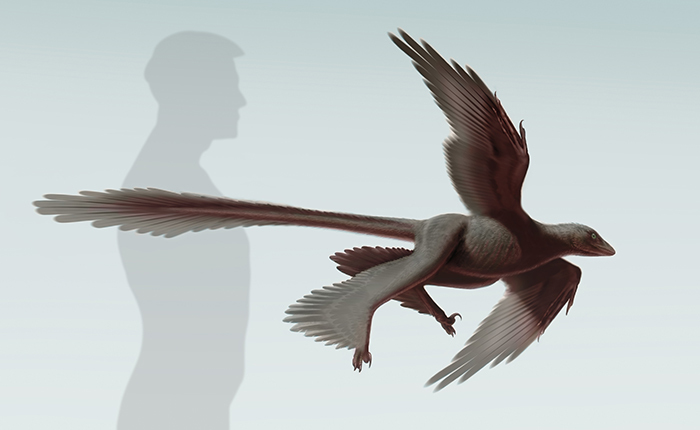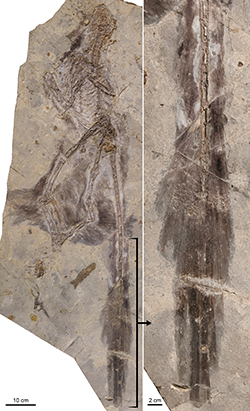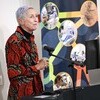125-million-year-old Changyuraptor sheds light on dinosaur flight
16 July 2014 | Story by Newsroom
An international team of experts, including Professor Anusuya Chinsamy-Turan from the University of Cape Town (UCT), has discovered a new predatory dinosaur with very long feathers that sheds light on how dinosaurs flew. The animal has a long-feathered tail that is believed to have been useful in decreasing descent speed and assuring safe landings.
The international research team was led by Dr Luis Chiappe, a palaeontologist from the Natural History Museum of Los Angeles County, United States of America. Their findings, which will be published in Nature Communications on 15 July 2014, show that with a weight of four kilograms, the 122cm-long Changyuraptor was the biggest of all four-winged dinosaurs. Analysing the bone microstructure of the Changyuraptor, Professor Chinsamy-Turan, a palaeobiologist and Head of the Department of Biological Sciences at UCT, said: "It shows that the animal was fully grown and that it had experienced at least five years of growth."
The fossil of the 125-million-year-old dinosaur, named Changyuraptor yangi, was found in the Liaoning Province of north eastern China. The location has produced a high number of discoveries in feathered dinosaur fossils over the last decade. The newly discovered dinosaur has a full set of feathers cloaking its entire body, including the extra-long tail feathers.
 Changyuraptor with details of plumage (Photo by Dr Luis Chiappe) |
According to Professor Chinsamy-Turan these microraptorine dinosaurs are known as the "four-winged" dinosaurs, because the long feathers attached to the legs have the appearance of a second set of wings.
"As we know birds have wings on their forelimbs. However, about 10 years ago predatory dinosaurs were discovered with wings on both their forelimbs, and hind-limbs," said Professor Chinsamy-Turan. "These recent discoveries pose an enigma as to how these microraptorine dinosaurs used their four wings to fly. Our new microraptor, Changyuraptor, is quite large, and we propose that its unusually long tail (30cm in length) helped to keep it airborne and could have assisted with landing."
The long feathers attached to both legs and arms of these ancient predators have led researchers to conclude that the four-winged dinosaurs were capable of flying. Dr Alan Turner from Stony Brook University in New York, one of the paper's co-authors, said: "Numerous features that we have long associated with birds in fact evolved in dinosaurs long before the first birds arrived on the scene. This includes things such as hollow bones, nesting behaviour, feathers and possibly flight."
Although it remains uncertain how well these creatures flew, the discovery does explain the role that the tail feathers played during flight control. For larger flyers, safe landings are of particular importance. "It makes sense that the largest microraptorines had especially large tail feathers '” they would have needed the additional control," added Dr Michael Habib, a researcher at the University of Southern California, USA, and another co-author of the paper.
The discovery of the Changyuraptor consolidates the notion that flight preceded the origin of birds, being inherited by the latter from their dinosaurian predecessors. "The new fossil documents that dinosaur flight was not limited to very small animals but to dinosaurs of more substantial size," said Dr Chiappe. "Clearly far more evidence is needed to understand the nuances of dinosaur flight, but the Changyuraptor is a major leap in the right direction."
Media release issued by Mologadi Makwela, UCT Communication and Marketing Department. Email: loga.makwela@uct.ac.za
 This work is licensed under a Creative Commons Attribution-NoDerivatives 4.0 International License.
This work is licensed under a Creative Commons Attribution-NoDerivatives 4.0 International License.
Please view the republishing articles page for more information.










